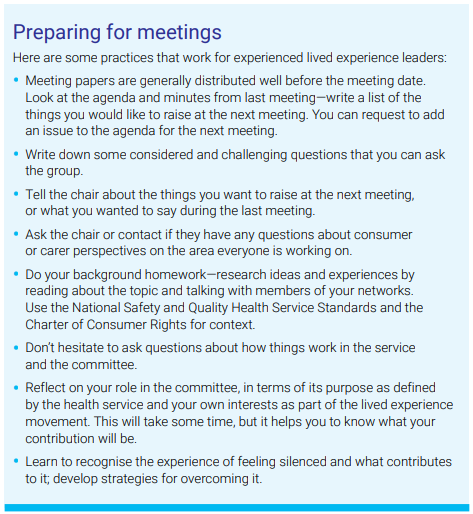Being heard and having influence
When preparing this guide, we talked with people about being an effective lived experience leader. They gave many suggestions about ways of being heard and having influence, as well as tips for navigating the challenging aspects of being an adviser or leader.
When preparing this guide, we talked with people about being an effective lived experience leader. They gave many suggestions about ways of being heard and having influence, as well as tips for navigating the challenging aspects of being an adviser or leader.
This section covers the areas of preparing for meetings, building confidence, communicating key issues, interpersonal and professional boundaries, dealing with conflicts and power imbalances, talking with networks, and community organisations.

Your values and communication skills
Being heard and having influence is about your values, your communication skills, learning about the health service context, and building relationships. Table 3 outlines important things to keep in mind.
Table 3: Values and communication skills
| Your preferred values | Your communication skills |
| Honesty and transparency Respect for self and others Contributing in goodwill Challenging thinking in constructive ways Being inclusive, and respecting diverse communities and experience Being positive and helpful—seeking to improve health outcomes for consumers and families, and their experience of the service |
Greetings and general conversation Asking relevant questions that expand thinking Reminding others of common consumer experiences and ideas Respecting your personal boundaries and those of others Being assertive, and having confidence in your preparation and knowledge Speaking from a consumer or carer perspective, not just your own story |
| Things to understand | Building relationships |
| Background and history of the committee; how it fits with other parts of the service Scope of the decision-making in the group; some things can be achieved in the group, whereas other issues must be approached in other forums Change occurs in small steps as well as big ones |
Getting to know the people in the group and their roles and interests. Looking for supporters of the lived experience voice (allies) Building a productive working relationship with the chair Meeting other people with lived experience at events and groups Meeting with the chair and other leaders individually |
Confidence in your role
Many consumers and carers are well aware of power imbalances when engaging with health services. You will probably engage with senior clinicians, service managers and leaders who have many years of experience, and formal qualifications. Some may even have been part of your own treatment and support team.
It’s time to reflect again on why you’re involved, and on the lived experience movement. You will recognise that you have been invited to bring a deep and rich understanding of the issues at hand. Your lived experience perspective is very different from the learned expertise of clinicians. You bring a consumer or carer perspective that’s a mix of your own story, what you have learned from others, and the values of lived experience. You can contribute thoughts, views and ideas that are independent of the professional and financial interests of the service, and of the health sector as a whole. You can remind others about rights and community standards.
Confidence takes time to develop but comes with experience, preparation and the support of your peers.
It’s important to evaluate whether the group recognises and values lived experience leadership and expertise. Does the group leadership recognise and engage with lived experience values? Are opportunities for leadership shared with you and other lived experience members?
The role of allies and supporters
People—such as clinicians—who work in non-designated lived experience roles can feel confronted as lived experience leaders and peer workers become more influential in decision-making. Reasons for this include increased accountability towards the lived experience perspective and the need to share power within decision- making. Much reflection is involved in considering issues of power, ethics and rights in service provision and decision-making. A key area of learning and development is to consider the role of allies for lived experience. Being an ally requires rethinking traditional professional–consumer relationships and taking a deliberate stance to support empowerment and social justice, as espoused in the principles throughout this guide.
Personal boundaries and recovery
Most people who become active in safety and quality are a fair way into their recovery journey. This helps because they have had time to reflect on their experience and distil key issues that need to be communicated to others.
Many lived experience leaders talk about the need for boundaries between your own experience and story and your work as a leader.
You may notice that mentors and experienced leaders do not always talk about their own stories during forums and meetings, or they might only use their story to reinforce a key point. This boundary achieves several things. It helps to focus their advocacy on the principles and issues being discussed, and to maintain privacy around their experiences and memories of mental health and distress. In addition, communicating through your story may require a lot of processing and time to settle, and may affect others in various ways. Repeatedly sharing your story as part of your advocacy and participation may also affect your recovery. Allow time for self-care checks.
Everyone has their own style. Choosing your boundaries is something all lived experience leaders need to do. An effective consumer leader is one who has integrated their experiences of mental distress into their lives, and gained value from their lived experience, and wisdom to share with others.
Building your networks
The lived experience movement is built on its membership and peer-support networks. It’s important that any role you undertake empowers you to connect with and maintain your networks of local people. This helps to deepen your knowledge of the views of others, and your connections support your role. When you bring strong networks to an advisory role, you strengthen your credibility and reflect the shared knowledge of your community networks. When you communicate faithfully with your networks, you build and deepen trust with your peers over time; they trust they can depend on you to communicate their perspectives in your advice and advocacy.
Confidentiality, communication and networks
A key issue is the confidentiality of safety and quality information. Health services will probably want confidentiality agreements in place for lived experience advisers who access and discuss this material. If you sign a confidentiality agreement, does it mean that you can’t talk with your networks about any aspects of this work?
Probably the best answer is that you can usually talk with others about the general areas of change that the health service is undertaking. You can also ask your network members questions about the topic without breaking confidentiality. For example, a health service is working on its discharge planning processes; you might share this with people and ask them about their best experiences around discharge planning.
Another key point is to check in with the chair about what you would like to communicate informally to your networks. Mostly, paperwork associated with a project is confidential and cannot be shared—it’s best to check. However, this doesn’t stop a service from preparing specific paperwork to assist external communication.
Partnerships with services
You need to know it’s the health service’s role to enable consultation with consumers, carers, families and kinship groups. It’s unrealistic to expect this of a lived experience consumer adviser or leader. One consumer or carer cannot represent the views of all consumers and carers.
Health services should build connections and partnerships with formal representative organisations such as Aboriginal Controlled Community Health Services, Elders, infant or parent health groups, specific cultural organisations, LGBTIQ+ networks, and consumer and carer peak bodies.
Many lived experience leaders participate in safety and quality projects while also sitting on other committees or being members of other organisations. For example, an Aboriginal Elder may also be a board member of an Aboriginal health service. If you are in this position and work within several organisations, it’s good to encourage providers of mental health services to connect directly with these organisations so you are not the only point of contact.
In some settings, you may feel it is difficult to voice quality-related concerns. Leaders based in regional and country areas have told us that it can be difficult to criticise local services—they worry about the impact on treatment relationships if there is only one mental health team and hospital in the area. In these instances, a useful strategy
is to talk with state consumer and carer bodies for some guidance on the best way to proceed. Another is to talk with a mentor to find the best approach for discussing improvements that you or your group want to see.




